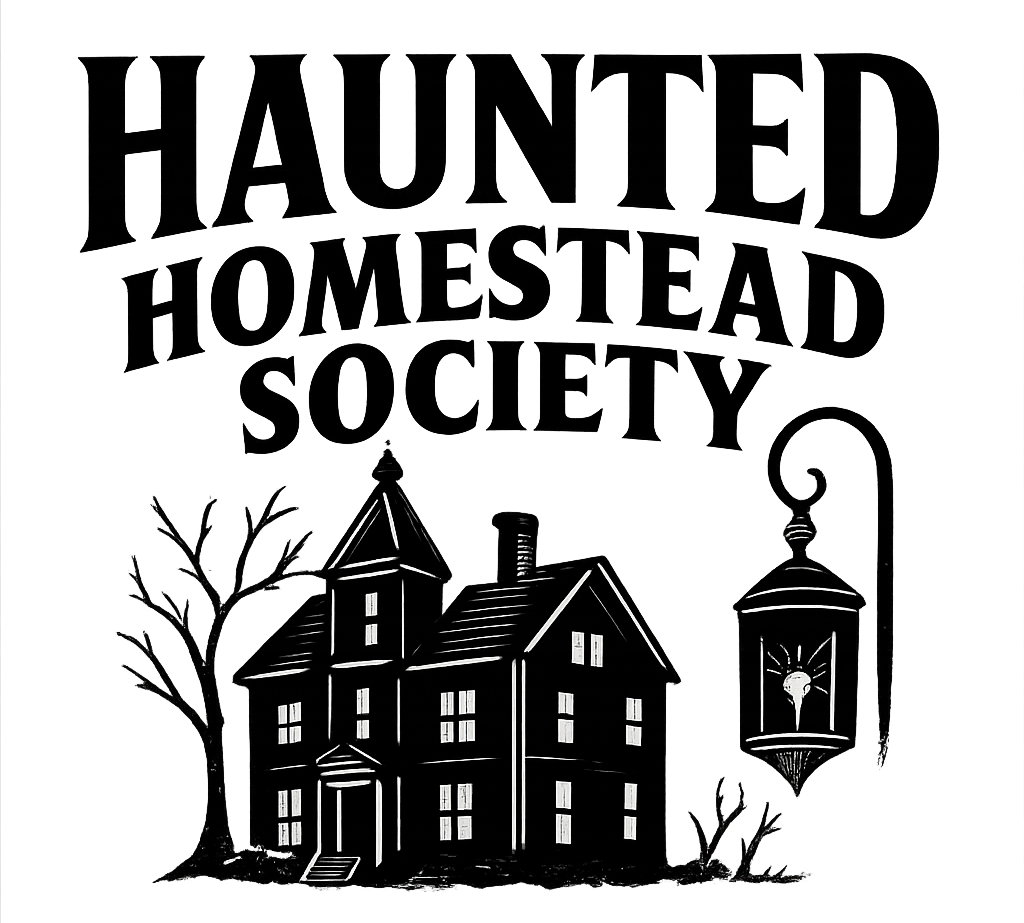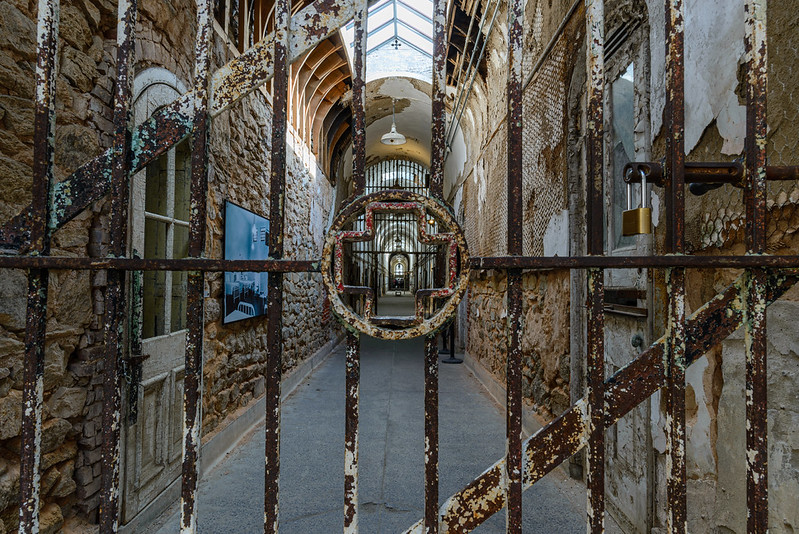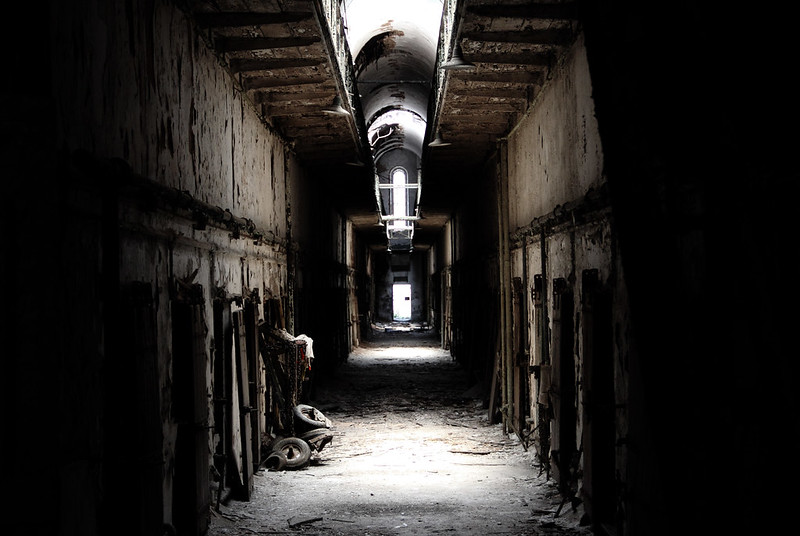
A Fortress of Isolation
Once the most expensive and advanced prison in the world, Eastern State Penitentiary in Philadelphia, Pennsylvania, now stands as a crumbling monument to human isolation—and one of the most haunted places in America. Opened in 1829, it was built on the radical idea that solitude could lead to penitence and moral reform. Prisoners were kept in total silence and complete isolation, eating, sleeping, and working alone in their cells. Even the guards wore soft shoes to muffle their footsteps. At the time, it was hailed as a humanitarian model, but in practice, Eastern State became a place of psychological torment that broke countless men’s minds.
Over the years, the prison housed some of the nation’s most notorious criminals, including Al Capone, who reportedly experienced ghostly visions during his stay. As decades passed, overcrowding and harsh conditions led to riots, disease, and despair. Prisoners and guards alike reported strange phenomena—echoing whispers, cold drafts in sealed corridors, and the feeling of being watched by unseen eyes. When Eastern State finally closed in 1971, it was left to decay, its cellblocks overtaken by vines and silence. Paranormal investigators believe the energy of centuries of suffering still lingers, with Cellblock 12, the old infirmary, and Death Row said to be the most active.
Today, Eastern State Penitentiary is a hauntingly beautiful ruin, open to the public as a historic site and popular ghost tour destination. By day, visitors walk through its echoing halls, learning about early prison reform; by night, they brave the famous “Terror Behind the Walls” haunted attraction or participate in guided paranormal investigations. Many leave convinced that something still walks those crumbling corridors—perhaps the restless spirits of those who never found redemption. Whether viewed as a masterpiece of architecture or a mausoleum of misery, Eastern State remains a chilling reminder that isolation can be far more haunting than chains.
Eastern State Penitentiary looms in the heart of Philadelphia like a Gothic monument to suffering. Its massive stone walls, radial layout, and iron gates were designed not just to contain—but to isolate. When it opened in 1829, it was hailed as a revolutionary experiment in criminal reform. The goal was penitence through solitude. The reality was psychological devastation.
Inmates were confined to individual cells with no contact with others. Guards placed hoods over their heads when they left their cells, ensuring they never saw another face. Meals were delivered through small slots. Exercise was limited to half an hour per day in a private yard. Bathing occurred once every two weeks—again, hooded.
The silence was total. And it drove many to madness.
The Birth of a Radical Idea
Eastern State was the first prison in the world to implement the “separate system” of incarceration. Designed by architect John Haviland, the prison’s radial floor plan—seven wings fanning out from a central hub—allowed guards to monitor inmates without being seen. It was inspired by the panopticon model, where surveillance created control.
The penitentiary was built to hold 253 inmates, each in solitary confinement. But as Philadelphia’s population grew, so did the prison’s. By the late 1800s, overcrowding forced changes. Cells meant for one held two or more. The silence fractured. The idealism faded.
Still, the architecture remained a monument to isolation. Vaulted ceilings, thick walls, and narrow corridors created an oppressive atmosphere that persists to this day.
The Pennsylvania System and Global Influence
Eastern State’s “Pennsylvania System” was based on Enlightenment ideals of rehabilitation through reflection. Reformers believed solitude would lead to remorse and moral transformation. The system was so influential that over 300 prisons worldwide adopted its design.
But critics emerged quickly. Charles Dickens visited in 1842 and condemned the system:
“I hold this slow and daily tampering with the mysteries of the brain to be immeasurably worse than any torture of the body.”
Reports of hallucinations, catatonia, and suicide became common. The prison’s silence was not healing—it was breaking minds.
Famous Inmates and Forgotten Souls
Eastern State housed some of the most notorious criminals in American history:
- Al Capone, who served time in 1929 for carrying a concealed weapon. His cell was unusually luxurious—complete with rugs, furniture, and a radio. But Capone reportedly suffered from haunting visions of “Jimmy,” a man believed to be a victim of the St. Valentine’s Day Massacre. Guards claimed he would scream at night, begging Jimmy to leave him alone.
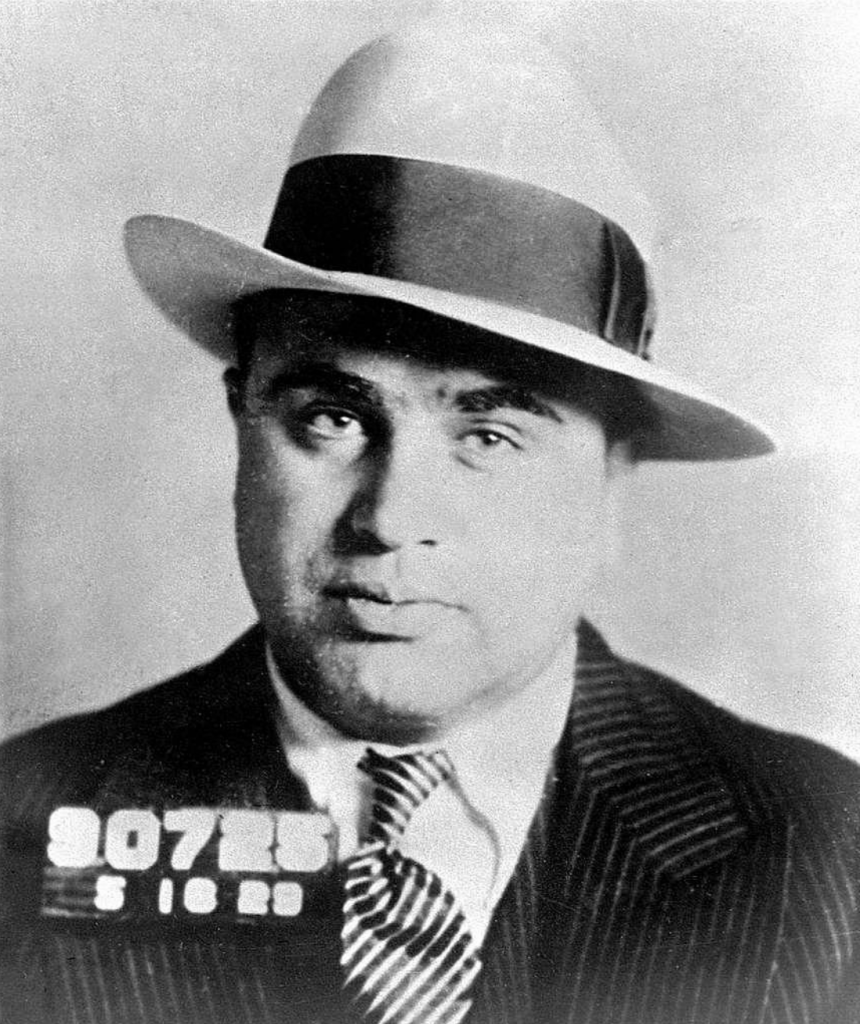
- Willie Sutton, the infamous bank robber, escaped in 1945 through a tunnel dug over a year with spoons and flattened cans. The tunnel stretched over 100 feet and included rudimentary lighting and ventilation.
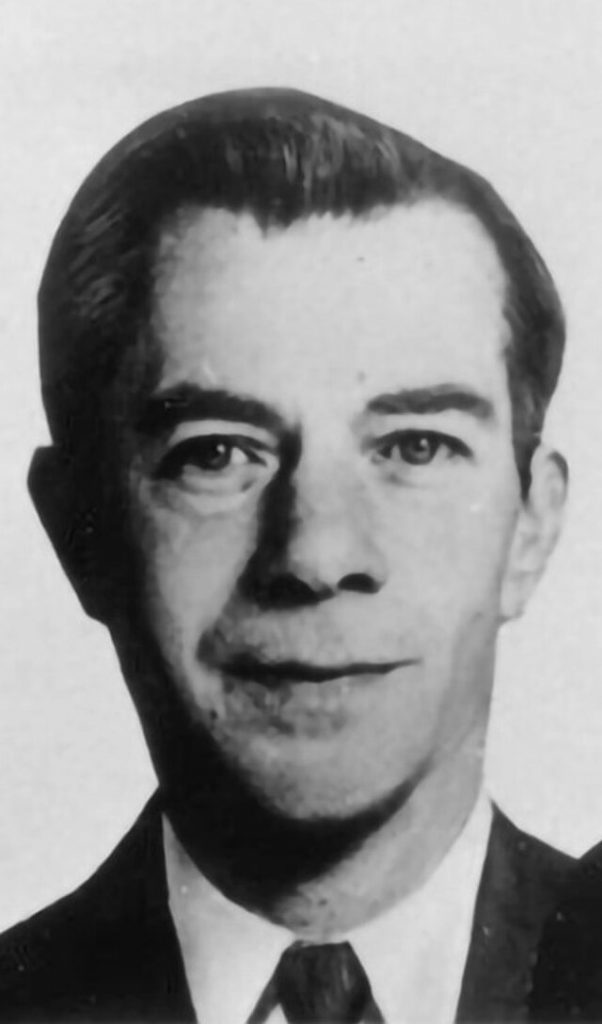
Most inmates, however, were not famous. They were poor, mentally ill, or simply unlucky. Many died within its walls. Some were buried in unmarked graves nearby. Their names are lost—but their presence may not be.
Cruelty Behind Closed Doors
Despite its reformist ideals, Eastern State became a place of cruelty. Punishments included:
- The Iron Gag: A device that clamped the tongue and was chained to the wrists. Any movement caused bleeding and pain.
- The Mad Chair: A restraint chair where inmates were bound for days without food.
- Ice Baths: Prisoners were dunked in freezing water and hung outside in winter.
- The Hole: A pitch-black underground cell used for extreme isolation.
These punishments left physical and psychological scars. Some inmates never recovered. Others never left.
Psychological Impact of Solitary Confinement
Modern studies confirm what Eastern State’s inmates experienced: solitary confinement causes severe psychological damage. Research shows:
- Increased risk of depression, anxiety, and hallucinations
- Higher rates of self-harm and suicide
- Long-term cognitive impairment
One study found that even short-term isolation can lead to irreversible trauma. At Eastern State, inmates were subjected to months or years of silence. The prison didn’t just punish—it dismantled minds.
Paranormal Activity – The Haunting Legacy
Since its closure in 1971, Eastern State has become one of the most investigated haunted sites in America. Eastern State Penitentiary isn’t just historically significant—it’s one of the most investigated haunted sites in America. Paranormal teams, psychics, and thousands of visitors have reported chilling phenomena across nearly every wing of the prison. The building’s oppressive architecture, history of suffering, and decades of isolation seem to have left behind more than just memories.
Cellblock 12 – The Shadow Corridor
This wing is infamous for shadow figures that dart between cells. Visitors often report seeing humanoid shapes standing silently in doorways or moving across hallways—only to vanish when approached. Paranormal investigators have captured:
- EVP recordings of whispers saying “Don’t leave me” and “I’m still here.”
- Thermal anomalies showing cold spots shaped like standing figures.
- Motion sensors triggered in empty cells.
One team described Cellblock 12 as “a place where the air feels thick with watching.”
Cellblock 4 – Laughter in the Dark
Cellblock 4 is known for disembodied laughter and voices. Tour guides have reported hearing giggles echoing from empty cells, often followed by the sound of footsteps. A psychic claimed the laughter was “a residual echo of madness.”
Notable phenomena include:
- Unexplained banging on cell doors
- Sudden temperature drops
- EVPs capturing phrases like “He’s coming” and “Hold still”
Death Row – The Weight of Judgment
The former death row wing carries an oppressive energy. Visitors often report nausea, dizziness, and feelings of dread. Paranormal teams have documented:
- Apparitions of men in jumpsuits pacing their cells
- Cold spots that move with investigators
- EVPs of prayers, sobbing, and the phrase “I didn’t mean to”
One investigator collapsed during a walkthrough, later saying, “It felt like someone was pressing down on my chest.”
Al Capone’s Cell – The Ghost of Jimmy
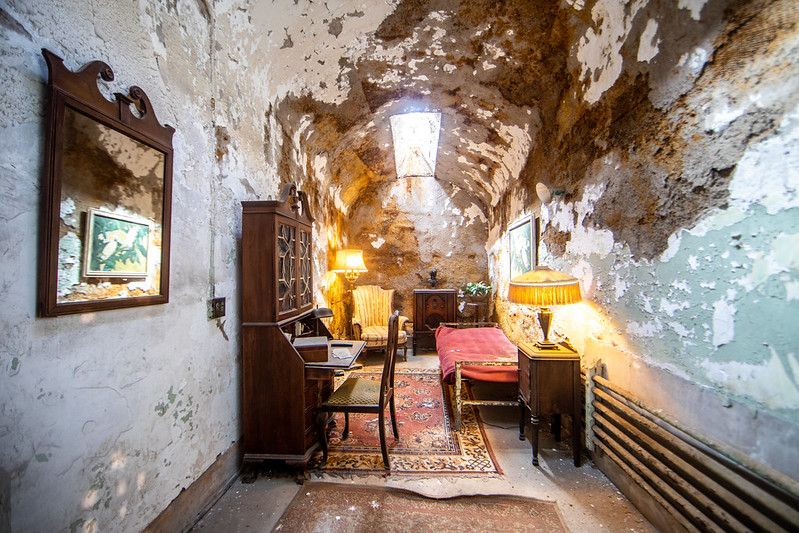
Al Capone’s cell is one of the most visited—and most haunted. During his incarceration, Capone reportedly suffered from visions of “Jimmy,” a man believed to be a victim of the St. Valentine’s Day Massacre. Guards claimed Capone would scream at night, begging Jimmy to leave him alone.
Modern investigators have recorded:
- EVPs of a man saying “I’m sorry” and “Jimmy, no”
- Unexplained cold drafts
- Furniture movement during overnight surveillance
The Ghost Dog
One of the more unusual hauntings involves the spirit of a dog. Believed to be a former guard’s companion, the dog is said to roam the cellblocks, howling and scratching at doors. Visitors have reported:
- Audible barking in empty wings
- Scratches on cell doors
- EVPs of panting and low growls
The dog’s presence is often described as protective—appearing before other phenomena intensify.
The Tower Watcher
A dark figure has been seen standing motionless at the top of the guard towers. It never moves, never speaks, and disappears when approached. Some believe it’s a residual imprint of a former guard. Others think it’s something else entirely.
Tour guides, visitors, and investigators have reported footsteps, slamming doors, and voices when no one else was present. One guide recalled locking up for the night and hearing a whisper behind him: “Still here.”
Scientific and Psychic Perspectives
Some researchers believe Eastern State’s architecture contributes to its haunting. The thick stone walls, radial design, and history of trauma create a “psychic echo”—a space that amplifies residual energy.
Sound distortion and electromagnetic interference are common. Paranormal teams have recorded EVPs, thermal anomalies, and unexplained cold spots. One investigator collapsed in Cellblock 8, claiming she was “overwhelmed by grief.”
Psychics describe the prison as “alive.” One medium refused to enter the surgical wing, saying, “There’s something still working in there.”
Skeptics point to psychological suggestion. But even they admit: Eastern State feels wrong.
Cultural Symbolism and Legacy
Eastern State is more than a haunted prison. It’s a symbol of America’s evolving relationship with punishment, isolation, and mental health. Its haunting reflects:
- Guilt: The penitentiary model was built on moral correction.
- Isolation: Silence as a tool of control.
- Redemption: The failed promise of reform.
Today, it stands as a museum and a warning. Its walls whisper not just ghost stories—but lessons.
Reader Poll
Vote and share your thoughts. The most compelling comment will be featured in next month’s post.
The Echoes Remain
Eastern State Penitentiary is a museum now. But the silence remains. The shadows still move. And the whispers never stopped.
It was built to inspire remorse.
Instead, it became a monument to suffering.
And the echoes still speak.
